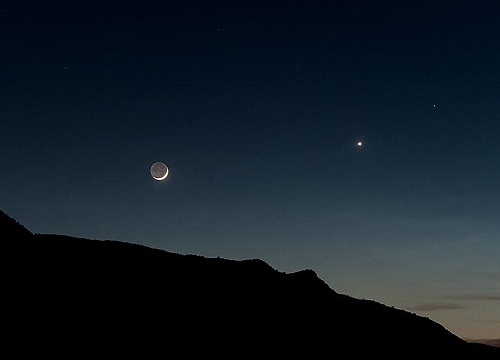 || A Closer Look at Venus
|| A Closer Look at Venus
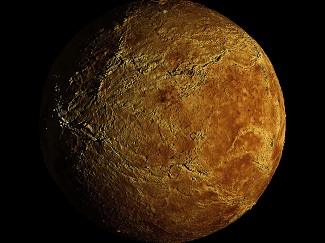
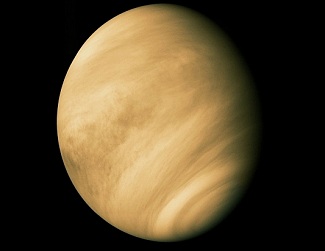
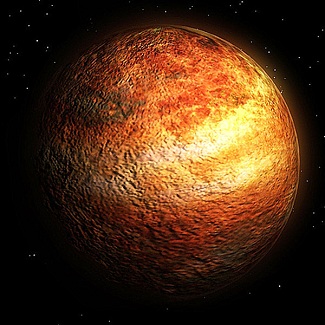
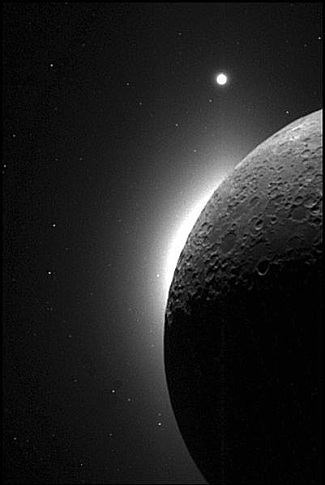 Clementine Startracker Image of the Moon obscuring the Sun, with Venus on top
Clementine Startracker Image of the Moon obscuring the Sun, with Venus on top
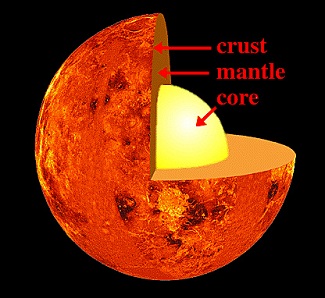 The Interior Layers of Venus
The Interior Layers of Venus
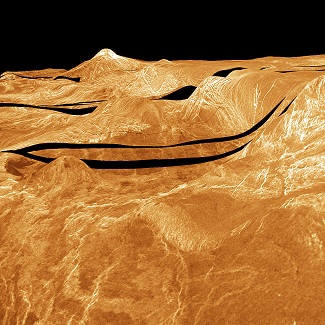 Simulated View of Maxwell Montes, a Volcano rising 11,000m above the Venusian Surface
Simulated View of Maxwell Montes, a Volcano rising 11,000m above the Venusian Surface
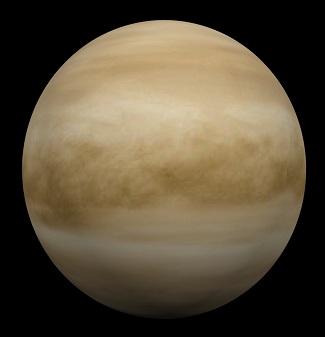 The Cloud-Obscured Orb of the Planet Venus. The thick Layer of Clouds consists principally of an Aerosol of Sulphuric Acid!
The Cloud-Obscured Orb of the Planet Venus. The thick Layer of Clouds consists principally of an Aerosol of Sulphuric Acid!
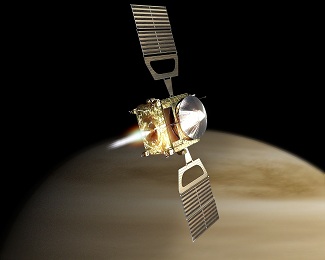
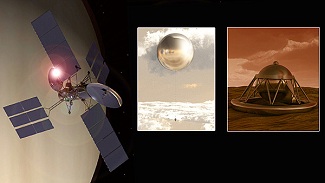
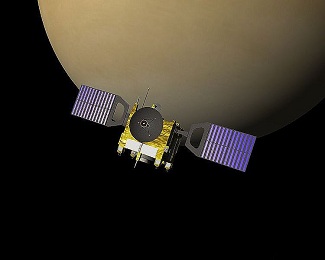
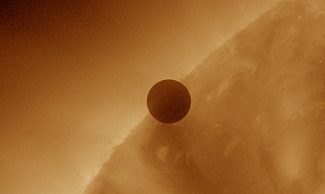 Impression of the Venus Transit as it occurred on June 5 - 6, 2012
Impression of the Venus Transit as it occurred on June 5 - 6, 2012
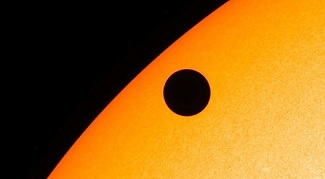 Spectacular Venus Transit
Spectacular Venus Transit
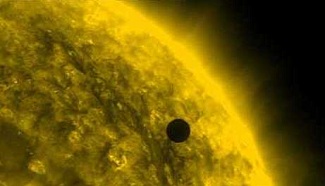 End of Spectacular Venus Transit
End of Spectacular Venus Transit
Venus
Venus, Second Planet from the Sun, Brightest Planet in Solar System

Facts about Venus:
Equatorial Circumference: 38,025 km
Distance from Sun: 108,200,000 km
Distance from Earth: 38,000,000 km (In Closest Possilbe Opposition)
Orbital Period (Around the Sun): 227.4 Earth Days
Average Orbital Speed (Around the Sun): 35.02 km/s
Equatorial Rotation Velocity:6.52 km/h (1.81 m/s)
Mean Density: 5.243 g/cm²
Mass:4.868 5×—10²⁴ kg (0.815 Earths)
Mean Surface Temp:462° C
The Planet Venus
History:
Venus is the second Planet from the Sun. After the Moon, it is the Brightest Natural Object in the Night Sky, reaching an apparent Magnitude of -4.6. Venus reaches its Maximum brightness shortly before Sunrise or shortly after Sunset, for which reason it has been referred to by Ancient Cultures as the Morning Star or Evening Star.
Venus is classified as a Terrestrial Planet and is sometimes called Earth's "Sister Planet": Similar Size, Gravity, and bulk Composition. (Venus is both the closest Planet to Earth and the Planet closest in Size to Earth).
Much of the Venusian Surface appears to have been shaped by Volcanic Activity. The Planet has few impact Craters, demonstrating the Surface is relatively young, approximately 300-600 Million years old.
About 80% of the Venusian Surface is covered by smooth, Volcanic Plains. Maxwell Montes, the Highest Mountain on Venus, lies on Ishtar Terra. Its peak is 11 km above the Venusian average Surface Elevation.
Internal Structure:
Venus is one of the four Solar Terrestrial Planets, meaning that, like the Earth, it is a Rocky Body. In Size and Mass, it is similar to the Earth. Conditions on the Venusian surface differ radically from those on Earth, owing to its dense Carbon Dioxide Atmosphere. The mass of the Atmosphere of Venus is 96.5% Carbon Dioxide, with most of the remaining 3.5% being Nitrogen.
The similarity in Size and Density between Venus and Earth suggests those are also to be found in the Internal structure: a Core, Mantle, and Crust.
Like that of Earth, the Venusian Core is at least partially liquid because the two planets have been cooling at about the same rate. The slightly smaller size of Venus suggests Pressures are significantly lower in its deep Interior than Earth.
The principal Difference between the two planets is the lack of evidence for Plate Tectonics on Venus.
Interior Comparison between 3 Planets: Venus, Earth & Mars
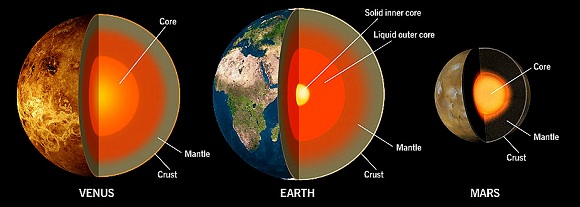
Characteristics of Venus
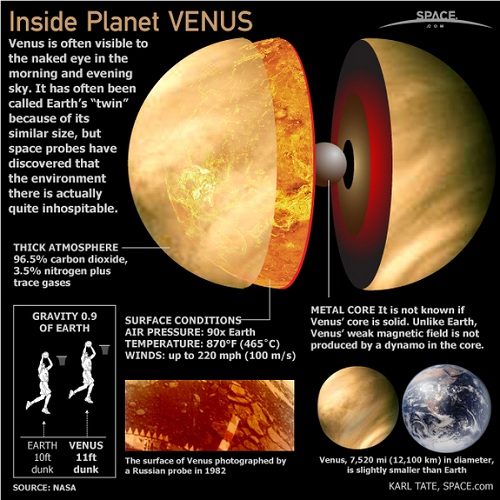
Atmosphere & Climate:
Venus has an extremely dense Atmosphere, which consists mainly of Carbon Dioxide and a small amount of Nitrogen.
The Atmospheric mass is 93 times that of Earth's Atmosphere, a pressure equivalent to that at a depth of nearly 1 kilometer under Earth's Oceans.
The CO2-rich Atmosphere, along with thick Clouds of Sulfur dioxide, generates the strongest Greenhouse effect in the Solar System, creating surface temperatures of at least 462°C. Venus' Surface is hotter than Mercury's, even though Venus is nearly twice Mercury's distance from the Sun.
The transfer of Heat by winds in the lower Atmosphere mean that the Temperature of the Venusian surface does not vary significantly between the Night and Day sides.
Above the dense CO2 layer of thick Clouds these Clouds reflect and scatter about 90% of the Sunlight that falls on them back into Space, and prevent Visual Observation of the Venusian Surface.
The Planet's minute Axial tilt (less than 3°, compared with 23° for Earth), also Minimizes Seasonal Temperature Variation.
The clouds of Venus are capable of producing lightning much like the clouds on Earth.
A Discovery made by the Venus Express Probe in 2011 shows that an Ozone Layer exists High in the Atmosphere of Venus.
The Exploration of Venus
Venus Express (VEX) is the first Venus Exploration mission of ESA.
Launched in November 2005, it arrived at Venus in April 2006 after 153 days of Journey and has been Continuously sending back Science Data from its Polar Orbit around Venus.
The Main Objective of the Mission is the Long Term Observation of the Venusian Atmosphere. The mission is currently funded by ESA until 31 December 2014.
Venus Express entered its target Orbit on 7 May 2006, when the Spacecraft was at 151 Million kilometres from Earth.
Now the Spacecraft is running on an Ellipse substantially closer to the Planet than during the initial Orbit. The Orbit now ranges between 66,000 and 250 kilometres over Venus and its Polar.
The Pericentre is located almost above the North pole and it takes 24 hours for the Spacecraft to travel around the Planet.
Venus Express is studying the Venusian Atmosphere and Clouds in detail, the Plasma Environment and the Surface characteristics of Venus from Orbit.
It will also make Global Maps of the Venusian Surface Temperatures.
Its nominal mission was originally planned to last for 500 Earth days (approximately two Venusian sidereal Days), but the Mission has been extended three times. On-board resources are sized for an additional 500 Earth Days.
Venus Probes as used so far for Exploration of the Planet:
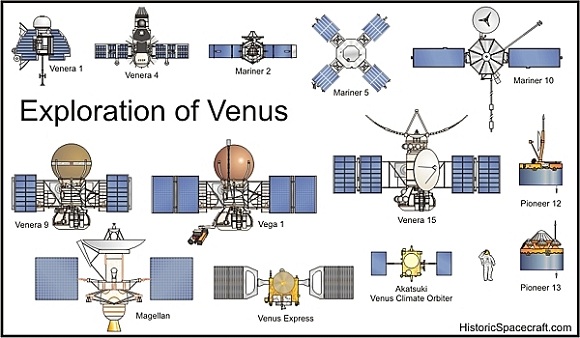
The Transit of Venus
The Venusian Orbit is slightly inclined relative to the Earth's Orbit, thus, when the planet passes between the Earth and the Sun, it usually does not Cross the Face of the Sun.
Transits of Venus do occur when the planet's Inferior Conjunction coincides with its presence in the Plane of the Earth's Orbit.
Transits of Venus occur in Cycles of 243 years with the current Pattern of Transits being Pairs of Transits separated by Eight years, at intervals of about 105.5 years.
The latest pair was June 8, 2004 and June 5 - 6, 2012. The Transit could be watched Live from many Online Outlets or observed Locally with the right Equipment and Conditions.
The following Pair will occur in December 2117 and December 2125.
On the evening of May 22 2012, the crescent Moon and the planet Venus made an attractive conjunction just after sunset in Portal, AZ.
